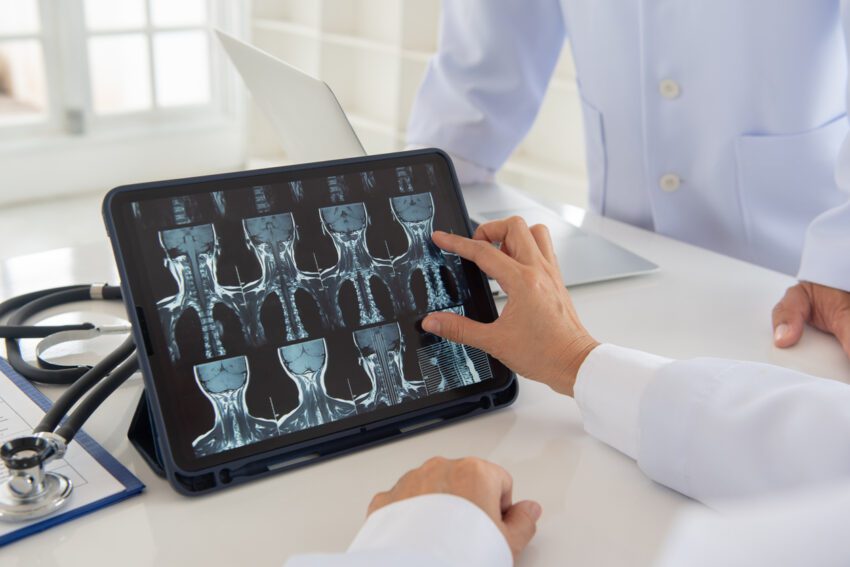Lumbar disc arthroplasty (LDA), also known as total disc replacement surgery, is a modern approach approved by the Food and Drug Administration (FDA) to safely and effectively treat severe and prolonged disc-related back pain while preserving spinal motion and function. This procedure involves replacing a damaged or degenerated intervertebral disc with an artificial disc implant, offering an alternative to traditional spinal fusion surgery, which aims to completely immobilize one or more unstable and painful vertebral levels.
When to Consider Surgery
Chronic discogenic pain results when one or more spinal discs are compromised by aging, wear, or injury to the cushioning disc between the vertebrae. To accurately diagnose the cause of pain, a physician will perform a thorough physical exam, and will likely order imaging studies including x-ray, MRI and/or CT of the lower spine to look for anomalies in the anatomy. Other diagnostic studies such as CT Discography may also be indicated. Lumbar disc arthroplasty is typically considered when nonoperative treatments such as physical therapy, chiropractic care, exercise programs, medications, and injections have failed to provide sufficient relief. Candidates for LDA generally meet specific criteria:
- Disc Degeneration: Patients experience severe disc degeneration leading to chronic low back pain and/or leg pain (radiculopathy).
- Stability: Candidates should not have significant spinal instability that may be better addressed by fusion surgery.
- Overall Health: Patients should be in good general health without medical conditions that could increase surgical risks.
- Failed Conservative Treatments: Symptoms persist despite attempting conservative therapies for an adequate duration (often around 6 months).
- Single or Two-Level Disease: LDA is typically recommended for patients with one or two-level disc disease.
Surgical Approach
Lumbar disc arthroplasty aims to alleviate pain, restore disc height, decompress nerves, and maintain spinal mobility. The surgery is performed using an anterior approach:
- Anterior Approach: This method involves accessing the lumbar spine through the abdomen. A lower abdominal incision allows the surgeon to move aside abdominal muscles and organs to reach the spine from the front. This approach offers direct access to the disc space, facilitating removal of the damaged disc and precise placement of the artificial disc implant without disrupting the spinal muscles.

Types of Implants
Two types of artificial disc implants are FDA-approved and available in the United States, each designed with unique materials and mechanisms, including:
- Prodisc L: A metal-on-plastic design, the prodisc L implant consists of metal endplates with a polyethylene core, allowing controlled motion at the treated level. This artificial disc is FDA-approved for one or two-level surgery.
- ActivL: The activL disc features a metal endplate with a high-density polyethylene inlay. This design aims to provide stability while facilitating natural spinal movement, and is FDA-approved for single-level use.
Hybrid Approaches
In complex cases involving multiple damaged discs, surgeons may consider hybrid approaches combining lumbar disc arthroplasty with fusion techniques. These hybrids address issues such as adjacent segment disease or multiple-level degeneration, aiming to optimize both motion preservation and spinal stability. The decision for a hybrid approach depends on thorough evaluation by the surgical team, considering the patient’s unique circumstances and surgical goals.
Off-label Use
Although primarily indicated for single or two-level disc disease, off-label uses of LDA have been explored:
- Adjacent Segment Disease: Some surgeons consider LDA for patients with adjacent segment disease, where discs adjacent to a previous fusion show degeneration and symptomatic pain.
- Multilevel Disease: While less common, LDA has been effectively used in selected cases involving more than two levels of disc degeneration.
- Hybrid Surgery: Described above, also represents off-label usage of artificial discs.
- Individual Considerations: Off-label uses require careful assessment of the patient’s anatomy, symptoms, and overall health to weigh potential benefits against risks.
Conclusion
Lumbar disc arthroplasty represents a significant advancement in treating disc-related low back pain while restoring and preserving normal spinal biomechanics. Patients considering this procedure should consult with a qualified spine surgeon to discuss their individual case, addressing potential risks, benefits, and expected outcomes based on current evidence and best practices in spine medicine.



